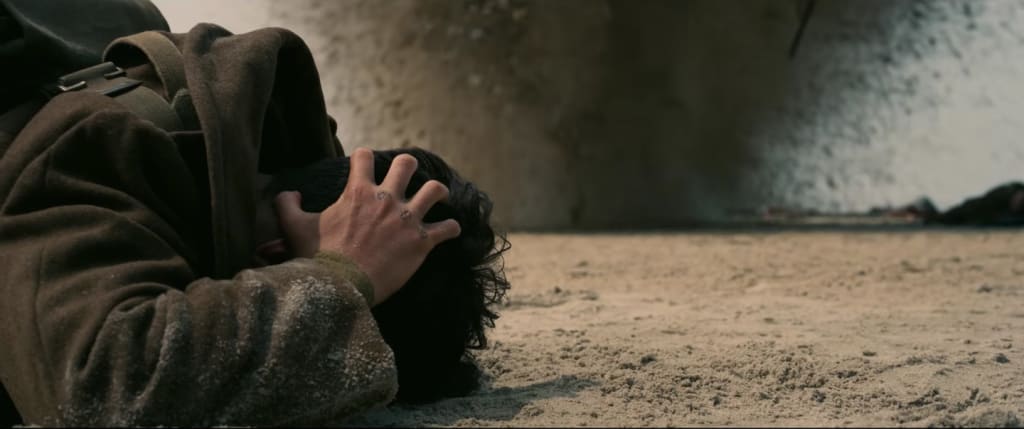Dunkirk Review
There's no hiding from this.

The clock didn’t stop, it just held its breath. It’s the prelude. It’s the darkest hour. It’s a beach that seems like it’s detached from the rest of civilization. It’s the grey skies or the churning murky blue-green of the sea. It’s the gargantuan landscape. The sound of German bombers and Stukas. It’s the Mole. The Sea. The Air. A week. A day. An hour. It’s at first disconnected moments, thrown out in a web of time that seeks to lock into place over separate levels. It’s brutal. Raw. Simple. It’s survival whittled down to its element. There’s no need to know the backstory, the tired exposition. The motivation. It’s all there in the action. The sound. The horror in the eyes. The emptiness.
It’s Dunkirk. Christopher Nolan’s stunning, beautiful, visceral film centered around Operation Dynamo - the British army stuck between enemy forces and the English Channel. Home practically in sight. It’s experimental in tone, the majority of the action dialogue free. Survival and war, neither needs an explanation. A minimalist epic wrought upon the largest canvas possible. It’s a towering, bewildering achievement of filmmaking that defies the narrative convention of war films. A triptych where time is manipulated, drawn together, the valve continuously tightened. Nolan’s obsession with time (and his slightly lesser one with drowning) is crystallized to perfection here. His technical mastery both serving and dominating the story.
And yet, somehow, because he’s working on such an abstract level on something that has been close to his heart, Dunkirk is Nolan’s most human film. A stirring ode to the human spirit in the face of overwhelming adversity (in the most British way possible). It is also, arguably, his most complete film, his predilection for precise world building and stringent logic cast off. You can see it in the astounding aerial dog fights - by far the most amazing action scenes of the year, the use of sound to convey feeling and emotion (usually terror) a refreshing lack of grand speeches or bogged down philosophical discussions. We’re experiencing, not watching or consuming. In contrast to the unbearable, claustrophobic tension, Nolan is operating at a level of freedom that is almost galling if it weren’t so accomplished.
That’s the same for every other aspect of the film. Hans Zimmer’s score is propulsive and thunderous. It borders on a nightmare, the one constant throughout, rising and falling, stretching and contracting as the editing dictates. Even the quiet moments, so often one of rumination and back story filler in other films, are brief interludes that draw out the tension instead of lessening it. There’s the tick and the tock, the strings that sounds like they’ve been transferred from an experimental horror film. The guitar wails mimicking sirens. It’s explosive, jarring, and soaring as if being in the cockpit of a Spitfire. Complemented by an altogether ferocious soundscape (this must be what hell sounds like).
The cinematography by Hoyt Van Hoytema makes full use of glorious IMAX. Moments of grand scale and tight intimacy trade blows. The faces pulled into stark, unyielding focus as everything around them becomes smeared and blurry - a world seeming to fall away to the mundane harshness of war. Where nature drifts into grey. It’s a mood piece no doubt. It starts in an oddly surreal way - following young soldiers through the streets of Dunkirk as Nazi propaganda floats down from the sky. It’s tranquil, out of place. The camera floats with them until the bullets hit, and we’re shaken out, scrambling for cover, not daring to look back. There’s no escape, the vastness of the image ramming it home that we are trapped alongside the soldiers. The enemy is a ghost. An existential threat. The soldiers live at the mercy of time and fate. The performances are instinctual, stripped down to the essentials. No one cares where you came from, you’re there, that’s all that matters.
The lead for The Mole is Tommy - pretty sure we don’t hear his name uttered once - and newcomer Fionn Whitehead plays him like a cross between a mute and a puppy. It’s efficient, effective, and quietly powerful. Kenneth Branagh oversees the evacuation, walking back and forth along a pier, born to squint stoically into the bitter sea winds. On the sea, Mark Rylance putters to Dunkirk - the civilian boats activated - and he’s the moral center of the film. It’s a low-key exertion, no need for theatrics. It’s brought into conflict with Cillian Murphy’s soldier that they pick up from a capsized boat. Reality and duty at war with each other. In the air, Tom Hardy’s face is once more hidden behind a mask, with minimal dialogue, fuel running out, and Stukas and bombers in the midst - all of it projected wonderfully through his eyes and small, assured movements.
You could argue that Dunkirk’s reverse nesting doll structure is ultimately a non-factor, narrative-wise. It arrives at the same place even if you laid it out in a more traditional manner. But that deflates the film, removes the magic, the uncertainty. The strange sense of wonder at how perspective is such an individual thing. It transfers urgency at multiple levels, often at the same time. It enhances the emotion. Time is always out of whack, and we are isolated to what others are experiencing. So to create such an intimate epic that threads these timelines together in a way that has you dropping your jaw at the precise moment it happens, as the bomber circles, the oil slicks across the water, the soldiers scramble to another boat, and help is temporarily unseen in the sky... well, that’s why. It’s the boldest, most powerful film of the year.
The clock resumes ticking.
About the Creator
Nicholas Anthony
Writer and nascent film-maker. I work under my Oraculum Films banner.






Comments
There are no comments for this story
Be the first to respond and start the conversation.